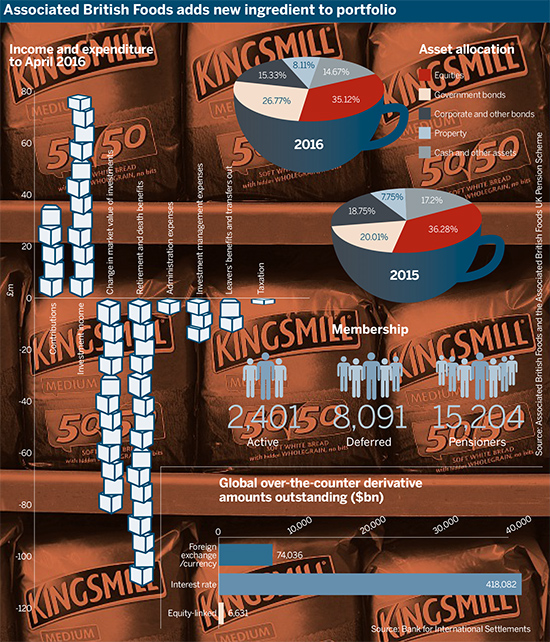The Associated British Foods’ UK defined benefit pension scheme has implemented an equities derivative overlay strategy to give added risk protection to its substantial portfolio of growth assets, maintaining a strong allocation to equities.
The Pensions and Lifetime Savings Association recently suggested schemes could bear greater investment risk, but experts said the maturity of many closed DB plans means significant investment in equities will remain a challenge.
What they’re trying to do is capture most of the upside of equities and limit some of the downside
Richard Butcher, PTL
The £3.64bn ABF scheme, which is still open to future accrual, increased its allocation to equities by £65m during the year to September, resulting in a total allocation of £1.28bn to the asset class.
The UK fund’s portfolio includes swap contracts held with a liability-driven investments manager, while it also has a relatively large equity allocation of about 35 per cent.
PLSA figures from 2015 show DB schemes, excluding the Local Government Pension Scheme, held about 28.7 per cent in developed market equities.
Covenant-driven investing
The ABF group’s overall pension deficit grew to £303m from £16m on an IAS 19 basis but in its latest report and accounts, the company explained: “When considered in the context of gross [global] pension assets of £4bn, and with the group’s strong balance sheet and substantial cash-generating ability, it is well within the group’s capacity to fund the future requirements of all these schemes.”
When assessing the right level of investment risk for a portfolio, Calum Cooper, head of trustee DB at consultancy Hymans Robertson, said integrating covenant risk is key: “It is essential to move away from looking at cash contributions, investments and covenant in the traditional one-dimensional or siloed way, and instead adopt a fully integrated approach that measurably incorporates long-term covenant risk.”
This would then enable schemes that are aware of the risks they currently run to tailor their risk and reward profile to the needs of their particular scheme and sponsor.
To mitigate some of the risk associated with a large allocation to equities, the ABF trustee also entered into an equity derivatives overlay strategy.
The fund’s annual report for the year states: “The objective of this is to use the purchase and sale of options on a reference index to target a set payoff profile. This objective will provide capital protection to the equity mandate.”
With a derivatives overlay, the scheme purchases a contract allowing it to hedge some of the risk that its investments will fall in value.
Richard Butcher, managing director at professional trustee company PTL, compared the strategy to an insurance policy.
“What they’re trying to do is capture most of the upside of equities and limit some of the downside,” he said.
Downside protection does not come without costs, particularly in what Butcher described as a somewhat niche market with few “available commoditised products”.
But he added that this cost, as with any insurance premium, would only seem unnecessary in the event that the scheme’s broader equity investment strategy is successful.
Shell diversifies away from equities over market fears
The Shell Contributory Pension Fund has diversified its growth asset portfolio and reduced its equity holdings in response to concerns about the level of risk.
Complex contracts
Instead, a greater barrier to pension scheme entry into the space might be a distrust, or even lack of understanding, of derivatives among trustees.
“It’s very difficult to assign a value to it, so where does it sit on the books?” said Butcher.
Options contracts might appear opaque as an investment, especially for schemes that lack the expertise and resources to dissect the complexities of derivatives.
But Butcher added that trustees should not let this deter them from attempting to understand the asset class.
“The principle of these things is perfectly sound,” he said.














